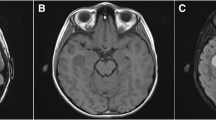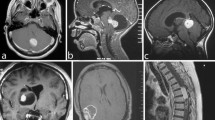Abstract
Background
Pilocytic astrocytoma is the most frequent pediatric glioma. Despite its overall good prognosis, complete surgical resection is sometimes unfeasible, especially for patients with deep-seated tumors. For these patients, the identification of targetable genetic alterations such as NTRK fusions, raised as a new hope for therapy. The presence of gene fusions involving NTRK2 has been rarely reported in pilocytic astrocytoma. The aim of the present study was to investigate the frequency of NTRK2 alterations in a series of Brazilian pilocytic astrocytomas.
Methods
Sixty-nine pilocytic astrocytomas, previously characterized for BRAF and FGFR1 alterations were evaluated. The analysis of NTRK2 alterations was performed using a dual color break apart fluorescence in situ hybridization (FISH) assay.
Results
NTRK2 fusions were successfully evaluated by FISH in 62 of the 69 cases. Neither evidence of NTRK2 gene rearrangements nor NTRK2 copy number alterations were found.
Conclusions
NTRK2 alterations are uncommon genetic events in pilocytic astrocytomas, regardless of patients’ clinicopathological and molecular features.

Similar content being viewed by others
Availability of data and material
The datasets used and/or analyzed during the current study available from the corresponding author on reasonable request.
Abbreviations
- AGBL4 :
-
AGBL carboxypeptidase 4.
- BAC :
-
Bacterial Artificial Chromosome.
- BRAF :
-
B-Raf proto-oncogene, serine/threonine kinase.
- CDKN2A/B :
-
Cyclin dependent kinase inhibitor 2 A/B.
- CNS :
-
Central Nervous System Tumor.
- dUTP :
-
2’-deoxyuridine 5’-triphosphate.
- FDA :
-
Food and Drug Administration.
- FGFR :
-
Fibroblast Growth Factor Receptor.
- FISH :
-
Fluorescence In Situ Hybridization.
- IDH :
-
Isocitrate Dehydrogenase.
- KANK1 :
-
KN motif and ankyrin repeat domains 1.
- KCTD16 :
-
Potassium channel tetramerization domain containing 16.
- KCTD8 :
-
Potassium channel tetramerization domain containing 8.
- KIF5B :
-
Kinesin family member 5B.
- KRAS :
-
KRAS proto-oncogene, GTPase.
- MAPK :
-
Mitogen-Activated Protein Kinase.
- MTAP :
-
Methylthioadenosine phosphorylase.
- NACC2 :
-
NACC (Nucleus accumbens associated) family member 2.
- NF1 :
-
Neurofibromin 1.
- NTRK :
-
Neurotrophic Tyrosine Receptor Kinase.
- PCR :
-
Polymerase Chain Reaction.
- PTPN11 :
-
Protein tyrosine phosphatase non-receptor type 11.
- QKI :
-
KH domain containing RNA binding.
- TMA :
-
Tissue microarrays.
References
Ostrom QT, Patil N, Cioffi G et al (2020) CBTRUS statistical report: Primary brain and other central nervous system tumors diagnosed in the United States in 2013–2017. Neurooncology 22:IV1–IV96. https://doi.org/10.1093/neuonc/noaa200
National Cancer Institute José Alencar Gomes da Silva (INCA) (2013) Cancer in Brazil - Data from the Population Based Registries. In: ISBN 978-85-7318-221-7. https://www.inca.gov.br/sites/ufu.sti.inca.local/files/media/document/cancer-in-brazil-vol4-2013.pdf. Accessed 6 Dec 2021
Louis DN, Perry A, Reifenberger G et al (2016) The 2016 World Health Organization Classification of Tumors of the Central Nervous System: a summary. Acta Neuropathol 131:803–820. https://doi.org/10.1007/s00401-016-1545-1
Louis DN, Perry A, Wesseling P, Brat DJ, Cree IA, Figarella-Branger D, Hawkins C, Ng HK, Pfister SM, Reifenberger G, Soffietti R, von Ellison DA D (2021) The 2021 WHO Classification of Tumors of the Central Nervous System: a summary. Neuro Oncol 23:1231–1251. https://doi.org/10.1093/NEUONC/NOAB106
Collins KL, Pollack IF (2020) Pediatric low-grade gliomas. Cancers (Basel) 12
Collins VP, Jones DTW, Giannini C (2015) Pilocytic astrocytoma: pathology, molecular mechanisms and markers. Acta Neuropathol 129:775–788
Jones DTW, Gronych J, Lichter P et al (2012) MAPK pathway activation in pilocytic astrocytoma. Cell Mol Life Sci 69:1799–1811
Chatterjee D, Garg C, Singla N, Radotra BD (2018) Desmoplastic non-infantile astrocytoma/ganglioglioma: rare low-grade tumor with frequent BRAF V600E mutation. Hum Pathol 80:186–191. https://doi.org/10.1016/j.humpath.2018.06.005
Breton Q, Plouhinec H, Prunier-Mirebeau D et al (2017) BRAF-V600E immunohistochemistry in a large series of glial and glial–neuronal tumors. Brain and Behavior 7. https://doi.org/10.1002/brb3.641
Gajjar A, Bowers DC, Karajannis MA et al (2015) Pediatric brain tumors: Innovative genomic information is transforming the diagnostic and clinical landscape. J Clin Oncol 33:2986–2998
Guidi M, Giunti L, Buccoliero A et al (2021) Genetic signature and treatment of pediatric highgrade glioma. Mol Clin Oncol 14. https://doi.org/10.3892/mco.2021.2232
Kurani H, Gurav M, Shetty O et al (2019) Pilocytic astrocytomas: BRAFV600E and BRAF fusion expression patterns in pediatric and adult age groups. Childs Nerv Syst 35:1525–1536. https://doi.org/10.1007/S00381-019-04282-1
Zhang J, Wu G, Miller CP et al (2013) Whole-genome sequencing identifies genetic alterations in pediatric low-grade gliomas. Nat Genet 45:602–612. https://doi.org/10.1038/ng.2611
Becker AP, Scapulatempo-Neto C, Carloni AC et al (2015) KIAA1549: BRAF Gene Fusion and FGFR1 Hotspot Mutations Are Prognostic Factors in Pilocytic Astrocytomas. J Neuropathol Exp Neurol 74:743–754. https://doi.org/10.1097/NEN.0000000000000213
Jones DTW, Hutter B, Jäger N et al (2013) Recurrent somatic alterations of FGFR1 and NTRK2 in pilocytic astrocytoma. Nat Genet 45:927–932. https://doi.org/10.1038/ng.2682
Ryall S, Tabori U, Hawkins C (2020) Pediatric low-grade glioma in the era of molecular diagnostics. Acta Neuropathol Commun 8. https://doi.org/10.1186/S40478-020-00902-Z
Tuna M, Amos CI, Mills GB (2019) Molecular mechanisms and pathobiology of oncogenic fusion transcripts in epithelial tumors. Oncotarget 10:2095–2111
Drilon A, Hornby Z, Bencardino K et al (2017) Safety and Antitumor Activity of the Multitargeted Pan-TRK, ROS1, and ALK Inhibitor Entrectinib: Combined Results from Two Phase I Trials (ALKA-372-001 and STARTRK-1). Cancer Discov 7:400–409. https://doi.org/10.1158/2159-8290.cd-16-1237
Drilon A, Laetsch TW, Kummar S et al (2018) Efficacy of Larotrectinib in TRK Fusion–Positive Cancers in Adults and Children. N Engl J Med 378:731–739. https://doi.org/10.1056/nejmoa1714448
Mullard A (2018) FDA approves landmark tissue-agnostic cancer drug. Nat Rev Drug Discov 18:7. https://doi.org/10.1038/NRD.2018.226
Pattwell SS, Konnick EQ, Liu YJ et al (2020) Neurotrophic Receptor Tyrosine Kinase 2 (NTRK2) Alterations in Low-Grade Gliomas: Report of a Novel Gene Fusion Partner in a Pilocytic Astrocytoma and Review of the Literature. Case Rep Pathol 2020:1–7. https://doi.org/10.1155/2020/5903863
López GY, Perry A, Harding B et al (2019) CDKN2A/B Loss Is Associated with Anaplastic Transformation in a Case of NTRK2 Fusion-positive Pilocytic Astrocytoma. Neuropathol Appl Neurobiol 45:174–178
Cocco E, Scaltriti M, Drilon A (2018) NTRK fusion-positive cancers and TRK inhibitor therapy. Nat Reviews Clin Oncol 15:731–747
Becker AP, Scapulatempo-Neto C, Menezes WP, Clara C, Machado HR, Oliveira RS, Neder LRR (2015) Expression of Methylthioadenosine Phosphorylase (MTAP) in Pilocytic Astrocytomas. Pathobiology 82:84–89. https://doi.org/10.1159/000430956
Schneider H Jr, Raffel C, McComb JG (1992) Benign cerebellar astrocytomas of childhood. Neurosurgery 30:58–62 discussion 62 – 3. https://doi.org/10.1227/00006123-199201000-00011
Ramkissoon SH, Bandopadhayay P, Hwang J, Ramkissoon LA, Greenwald NF, Schumacher SE, O’Rourke R, Pinches N, Ho P, Malkin H, Sinai C, Filbin M, Plant A, Bi WL, Chang MS, Yang E, Wright KD, Manley PE, Ducar M, Alexandrescu S, Lidov H, Delalle I, Goumnerova LK (2017) Clinical targeted exome-based sequencing in combination with genome-wide copy number profiling: precision medicine analysis of 203 pediatric brain tumors. Neuro Oncol 19:986–996. https://doi.org/10.1093/NEUONC/NOW294
Clarke M, Mackay A, Ismer B et al (2020) Infant High-Grade Gliomas Comprise Multiple Subgroups Characterized by Novel Targetable Gene Fusions and Favorable Outcomes. Cancer Discov 10:942–963. https://doi.org/10.1158/2159-8290.CD-19-1030
Dunn B, PharmD D (2020) Larotrectinib and Entrectinib: TRK Inhibitors for the Treatment of Pediatric and Adult Patients With NTRK Gene Fusion. J Adv Practitioner Oncol 11:418. https://doi.org/10.6004/jadpro.2020.11.4.9
Gambella A, Senetta R, Collemi G et al (2020) NTRK Fusions in Central Nervous System Tumors: A Rare. but Worthy Target
Rohrberg KS, Lassen U (2021) Detecting and Targeting NTRK Fusions in Cancer in the Era of Tumor Agnostic Oncology. Drugs 81:445–452. https://doi.org/10.1007/S40265-020-01459-W
Shulman DS, DuBois SG (2020) The Evolving Diagnostic and Treatment Landscape of NTRK-Fusion-Driven Pediatric Cancers. Paediatr Drugs 22:189–197. https://doi.org/10.1007/S40272-020-00380-9
Solomon JP, Linkov I, Rosado A et al (2020) NTRK fusion detection across multiple assays and 33,997 cases: diagnostic implications and pitfalls. Mod Pathol 33:38. https://doi.org/10.1038/S41379-019-0324-7
Deland L, Keane S, Olsson Bontell T et al (2021) Discovery of a rare GKAP1-NTRK2 fusion in a pediatric low-grade glioma, leading to targeted treatment with TRK-inhibitor larotrectinib. Cancer Biol Ther 22:184–195. https://doi.org/10.1080/15384047.2021.1899573
Ryall S, Zapotocky M, Fukuoka K et al (2020) Integrated Molecular and Clinical Analysis of 1,000 Pediatric Low-Grade Gliomas. Cancer Cell 37:569–583e5. https://doi.org/10.1016/J.CCELL.2020.03.011
Torre M, Vasudevaraja V, Serrano J et al (2020) Molecular and clinicopathologic features of gliomas harboring NTRK fusions. Acta Neuropathol Commun 8:107. https://doi.org/10.1186/s40478-020-00980-z
Acknowledgements
This study was partially supported by National Council for Scientific and Technological Development (CNPq), Brazil; São Paulo Foundation for Research Support (FAPESP), Brazil; Coordination for the Improvement of Level Personnel (CAPES), Brazil; The Cancer Center Support Grant (CCSG), USA.
Funding
National Council for Scientific and Technological Development (CNPq- 475358/2011-2) and São Paulo Foundation for Research Support (FAPESP − 2012/19590-0) grants to Rui Manuel Reis and the NIH-P30CA046934 (CCSG Molecular Pathology/Cytogenetics) to Marileila Varella-Garcia. Weder Menezes was a recipient of a Coordination for the Improvement of Level Personnel (CAPES, Brazil) fellowship.
Author information
Authors and Affiliations
Contributions
Daniel Antunes Moreno: Data analysis, results discussion, manuscript writing. Aline Paixão Becker: Data collection, experimental procedures, manuscript review. Cristovam Scapulatempo-Neto: Pathological review of tumor samples, manuscript review. Weder Menezes: Experimental procedures, data analysis. Jamie Sheren: experimental procedures, data analysis, manuscript review. Aline M Walter: experimental procedures, data analysis, manuscript review. Carlos Clara: Medial reports analysis, patients’ treatment protocol review. Hélio R. Machado: Medial reports analysis, selection of patients for the study. Ricardo S. Oliveira: Medial reports analysis, selection of patients for the study. Luciano Neder: Pathological review of tumor samples and manuscript review. Marileila Varella-Garcia: experimental procedures, data analysis, manuscript review. Rui Manuel Reis: Supervisor and project coordinator, results discussion, manuscript review and writing.
Corresponding author
Ethics declarations
Ethical standards
The study was approved by local Ethics Committee of Barretos Cancer Hospital, Barretos (number HCB/87362), and Ribeirão Preto Medical School, University of São Paulo, Brazil (HCRP/212313) and is in accordance with the 1964 Helsinki declaration and its later amendments or comparable ethical standards.
Competing interests
The authors declare that they have no competing interests.
Additional information
Publisher’s note
Springer Nature remains neutral with regard to jurisdictional claims in published maps and institutional affiliations.
Rights and permissions
About this article
Cite this article
Moreno, D.A., Becker, A.P., Scapulatempo-Neto, C. et al. NTRK2 gene fusions are uncommon in pilocytic astrocytoma. Mol Biol Rep 49, 7567–7573 (2022). https://doi.org/10.1007/s11033-022-07567-y
Received:
Revised:
Accepted:
Published:
Issue Date:
DOI: https://doi.org/10.1007/s11033-022-07567-y




